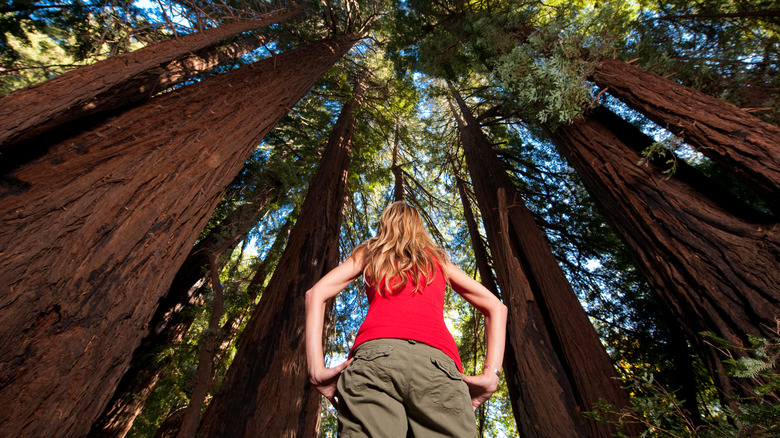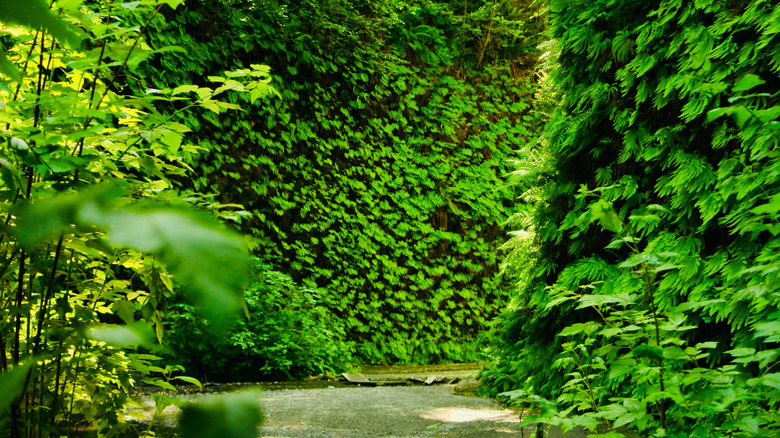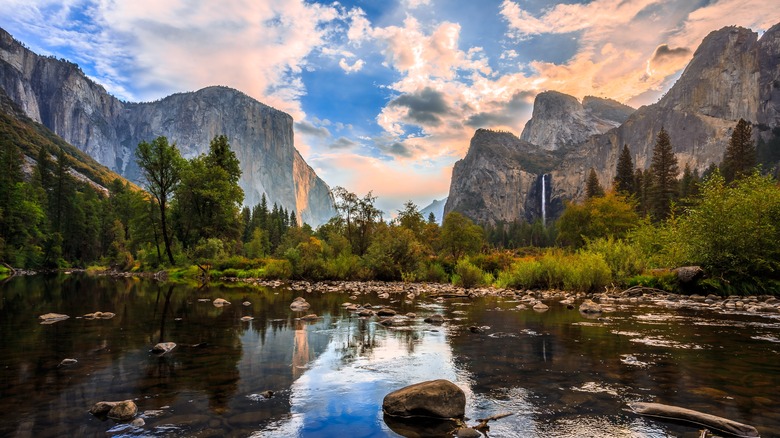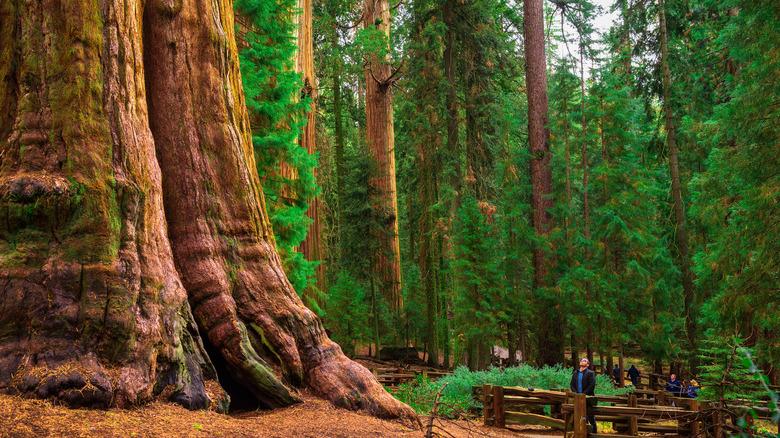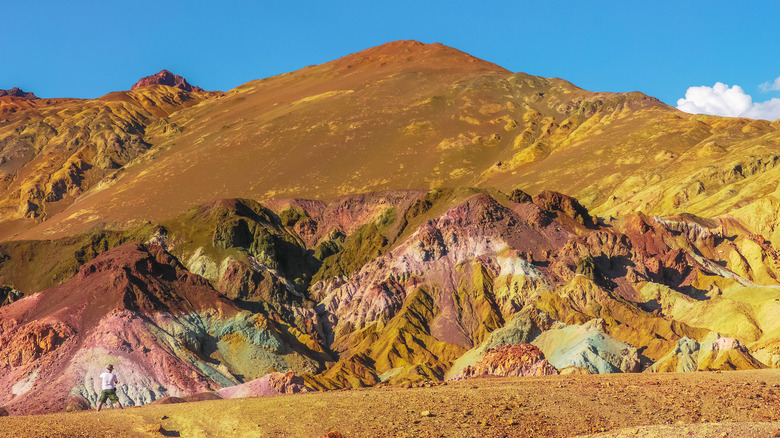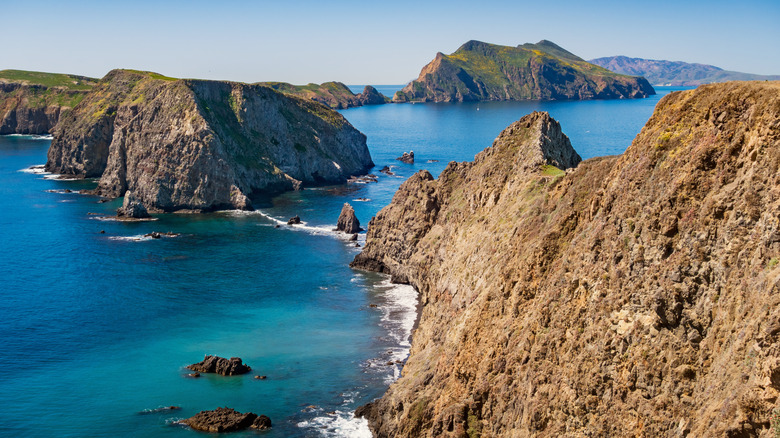The Perfect Road Trip Itinerary To Explore Every National Park In California
From temperate coastal rainforests to windswept islands brimming with biodiversity and ravishing yet forbidding deserts that have passed for other planets in the movies — the diversity of California's natural landscapes is unparalleled. It's no surprise that the Golden State has more national parks than any other state in the U.S., all nine of which can be combined, with some strategic planning, into one epic, 1,600-mile road trip.
If you're going to do this circuit (#vanlife, anyone?), you'll want to miss both the snows that close the road into Lassen Volcanic National Park from roughly November through May and the punishing summer heat in Death Valley, where temps average over 110 degrees Fahrenheit June through August. The good news is that September and October are glorious times to visit — with fewer crowds than in the summertime. Alternatively, you could break this trip into season-appropriate sections. Whether you complete this grand tour in a month, a year, a decade, or a lifetime, it's not to be missed.
A word of advice: Don't try to wing it. Make your reservations early, because even if you're not a camper, options like the cool canvas cabins at Yosemite's Curry Village can be hard to book. If you miss out or have holes in your itinerary, you can sign up for a service like CampNab, which will notify you of cancellations on your preferred dates. Now grab your America The Beautiful National Parks Pass and hit the road!
From coastal redwoods to Lassen's active volcanoes
The drive through Redwood National and State Parks is one of the most epic road trips on the planet, but you'll want to stop at some of the short trails that loop through groves of the world's tallest trees. The most scenic of these is the Stout Memorial Grove, where you can pad in hushed silence along a trail so soft with forest duff you could happily go barefoot. Trees over 2,000 years old form a verdant cathedral around you, and in the late afternoon, the slanting sunlight can even seem like it's shining through green stained glass. Another sight to behold is Fern Canyon (pictured above), where you meander up a shallow creek bed (rangers recommend water shoes) whose vertical walls are lined with fronds so green they seem made of neon.
Drive 200 miles west to Lassen Volcanic, California's most underrated national park. Although the park is still building back from the 2021 Dixie Fire(the largest in California history), our favorite attraction — Bumpass Hell — was untouched. The geothermal springs form a 16-acre natural cauldron where plumes of sulfurous steam waft up from pools of boiling mud and shoot out of fumaroles, or steam vents. The hydrothermal pools roil away at a brisk 240 degrees Fahrenheit, so don't stray off the park's boardwalks, as it's easy to get burned. Fancy climbing an active volcano? If you're fit, the views from Lassen Peak are worth the steep 5-mile trek.
Yosemite Valley's secret vistas
Another 300 miles southeast will get you to Yosemite Valley, where walking or biking along the paved paths winding through the valley floor will have you thinking you strayed into a photo by Ansel Adams. Every vista is iconic, from El Capitan to Half Dome and roaring Mist Falls. You've seen all this in countless pictures — and you probably still have white knuckles from watching Alex Honnold climb El Cap without a rope in the Oscar-winning 2018 documentary "Free Solo" — but the valley is definitely worth seeing in person.
Once you've toured the valley, our insider advice is to head up Tioga Road to Tuolumne Meadows. Here, you'll find lesser-known hikes, like the challenging trek to Cloud's Rest (this one is only for experienced hikers) and the easier hike to North Dome, both of which yield views of the valley below that few tourists get to see. For an extra-special idyll, take a 2.5-mile round-trip hike to pretty May Lake, then if you're game, hike and scramble up to the top of Mount Hoffmann to see lakes and mountains stretch below you to infinity — at 6 miles round-trip, it's a lot of reward for the effort. Alternatively, skip the hiking and have a lazy picnic and swim day on the shores of Tenaya Lake, the rare alpine lake you can get to by car.
From Pinnacles to Sequoia & Kings Canyon
Before leaving for Pinnacles National Park less than 200 miles away, you'll have to decide between the east and west entrances, as the two are not connected. Pick the east side for camping. If you aren't afraid of heights, hike the Condor Gulch Trail (which has railings on the steepest sections) for the most dramatic views and the best chance of spotting one of the trail's namesake birds. If the bird you see has a 5-foot wingspan, that's probably a turkey vulture, as a condor's wings span a truly awe-inspiring 9.5 feet.
Drive 160 miles inland, and you'll reach Sequoia & Kings Canyon. Those coastal redwoods were tall, but the giant Sequoias you'll see in these twin national parks are truly massive. The biggest tree in the world by volume, Sequoia's General Sherman Tree (pictured above) takes up over 52,000 cubic feet by volume and is 36 feet in diameter. Definitely explore the nearby Congress Trail for even more trees. One AllTrails reviewer reported being "awestruck by these towering sentinels."
You saw the lowest point in the continental U.S. in Death Valley, and you can see the highest in the contiguous states here: the 14,494-foot Mt. Whitney. The peak lies within Kings Canyon National Park, but getting a good view of it is geographically challenging. The best view is from the parking lot of the Eastern Sierra Interagency Visitor Center on Highway 395.
From Death Valley to Joshua Tree
Fancy a visit to Tatooine, Jabba the Hutt's home planet? Star Wars director George Lucas filmed scenes from "A New Hope" and "Return of the Jedi" all over Death Valley at sites like Dante's View, rated as the park's number one attraction on Tripadvisor. At over 5,000 feet, it overlooks Badwater Basin, the lowest point in the continental U.S. at 282 feet below sea level. Next, drive down to Badwater to explore the salt flats, where a short walk takes you to see incredible, sculptural salt polygons. Just be off the desert floor before 10 a.m., as the intense heat here makes Death Valley one of the world's most dangerous parks. Don't miss the scenic drive through Artists Palette (pictured above), a winding 9-mile loop through hills and canyons that get their intense colors from volcanic mineral deposits. Time your drive for sunset or sunrise, and this abstract masterpiece will come to life in the changing light.
Joshua Tree National Park gets its name from the distinctive Yucca plants that stand sentinel all over the desert. If you only camp once on this trip, do it here, as Joshua Tree is an International Dark Sky Park where you can see galaxies galore. If you have kids, stay at the Jumbo Rocks Campground, where the rocks beg to be climbed. When you bed down, leave the rain fly off your tent so you can watch the stars through the bug netting.
End your trip with some Channel Islands time
Channel Islands National Park is the last destination on your itinerary, and your road trip is about to turn into a boat trip. Of the five islands known as America's Galapagos, only Santa Catalina is inhabited. Most visitors take the ferry straight to Avalon's restaurants, casino, and busy harbor, but we prefer Two Harbors. Here, the island narrows, so you can walk between Catalina Harbor — where, in fall, you might spot cruising sailboats stopping on their way to Mexico — and Isthmus Cove. Catalina is one of the most stunning snorkeling destinations in the US, and you can explore a kelp forest among bright orange Garibaldi fish, then lounge on the beach with a cocktail under palm trees planted for the filming of "Mutiny on the Bounty" in 1935, when Catalina stood in for the South Pacific.
Drive 75 miles north to Oxnard and join an excursion to explore craggy Anacapa Island's chain of sea caves by kayak. For a mellower adventure, you can take a ferry from Ventura or Santa Barbara to uninhabited Santa Cruz Island, taking in views of Anacapa's dramatic Arch Rock on the way. On Santa Cruz, you have a good chance of spotting a bald eagle or glimpsing what may just be the cutest wild animal you will ever see: the 4-pound island fox, recently rescued from the brink of extinction. Unafraid of humans, these adorkable, cartoonish characters wander around everywhere without a care in the world.
